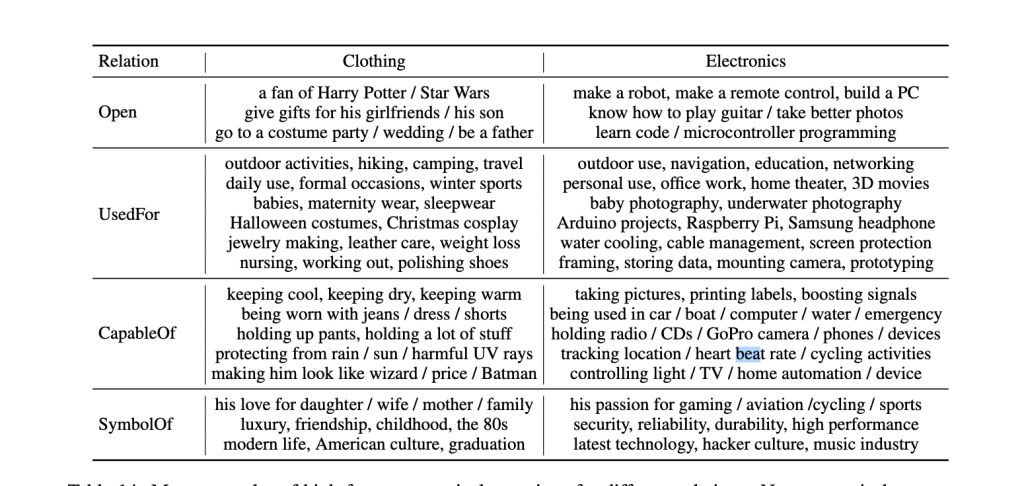User intent is inherently complex and is best modelled or represented in a nuanced and contextual manner. As I have stated in previous discussions, we cannot simply categorise user intent into informational, navigational, commercial, and transactional and expect to capture the multilayered and dynamic nature of consumer behaviour.
In the Folkscope project by the Amazon Science team, intentions were generated from co-buy transactional data across categories such as electronics and clothing. The Intention Knowledge Graph project by the same team acknowledges the challenge of understanding intentions in online platforms. The researchers also noted that many existing works on intention knowledge graphs often lack sufficient focus on connecting intentions, an aspect believed to be vital for modelling user behaviour and predicting future user actions.
Abstract intentions play a useful role as the conceptual umbrella under which concrete intentions are connected.
A Quick Look at Concrete Intentions
In the Intention Knowledge Graph project, Amazon’s research team identified both concrete and abstract intentions by analysing users’ co-purchasing behaviour. Concrete intentions are typically expressed as noun or verb phrases, with verb phrases often shown in italics.
An item’s core or integral features can be tagged as intentions. For example, “Waterproof” could be considered a key attribute and, therefore, an intention. The focus of concrete intent is mainly on immediate use cases, product specifications, and key features. These often rely on commonsense relations such as UsedFor, HasProperty, HasA, and CapableOf.

The “waterproof” feature, for instance, is derived from the HasProperty relation. IsA relations also provide additional concrete intentions, as a product’s conceptual positioning is integral to its identity, for example, IsA Skiing Product or IsA Camping Product. It can be argued that a product’s overall class or taxonomy, together with its integral features, comprises nouns that make up its concrete intentions.
The verbal aspect of these concrete intents can be linked to the product’s features and classification. They introduce a commonsense element that helps develop more distilled or coarse-grained intentions, which are not often mentioned in classical intention-modelling projects or reflected in search marketing applications.
From the examples provided, relations such as UsedFor and CapableOf generate verbal intentions like feel cool, feel warm, tell the time, or protect one’s laptop. These form part of the verbal concrete intentions.
In essence, a product’s intentions can be viewed as a combination of its features, classification, and functional (verbal) elements. The interplay of these dimensions helps define the concrete intentions that can be assigned to a given product.
Beyond functional and conceptual relations, there is also an open relational element that produces intentions such as fan of Apple products, feel cool, or feel warm. The table below (from the original study) highlights several of these open relations as they apply to the clothing and electronics product categories.

Exploring the Need for Abstract Intentions
In the Amazon Intention Graph example, based on co-buy pairs, abstract intentions such as fans of electronics, protect one’s devices, feel good, and outdoor activity product were generated.
Abstract intentions can be viewed as higher-level groupings of related concrete intentions, guiding multiple concrete actions. Concrete intentions are usually more functional and directly related to the product’s use or features. For example, a product and search term like Nike Pegasus 41 will have concrete intentions tied to its taxonomy, running shoes or women’s running shoes, as well as additional concrete intentions such as sustainability or sustainable running shoes, since the product is made with about 50% recycled content and features lightweight cushioning with a breathable upper mesh.
Based on a product’s classification and core features, we can infer or deduce intentions grounded in its unique characteristics. On Nike’s official website, the core positioning for the Pegasus 41 is described as providing “dual-layer responsive cushioning for an energised and comfortable ride.” From this, we can infer abstract intentions related to comfort and performance.
While concrete intentions relate to tangible product features, abstract intentions extend beyond functionality to encompass the user’s overall goals, emotional state, and desires. In this example, comfort and sustainability may be considered abstract intentions. Commonsense relations such as MotivatedByGoal, Causes, and Desires can help define these higher-level intents.
The advantage of modelling abstract intentions is that they help cluster products with varying concrete features under shared user goals, offering a more holistic understanding of consumer intent. For instance, an abstract intention like sustainable running gear could encompass running shoes, tops made from recycled polyester, or reusable water bottles. This makes abstract intent modelling particularly useful for recommendation engines and personalised search.
Intention modelling is inherently complex and extends far beyond simple categorisation. By exploring both concrete and abstract dimensions, organisations can gain deeper insight into consumer motivations and behaviours, ultimately unlocking greater strategic and predictive value in their data-driven decision-making processes.